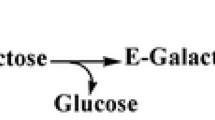Abstract
Objectives
To improve the thermostability and catalytic property of a mesophilic 1,3-1,4-β-glucanase by combinational mutagenesis and to test its effect in congress mashing.
Results
A mutant β-glucanase (rE-BglTO) constructed by combinational mutagenesis showed a 25 °C increase in optimal temperature (to 70 °C) a 19.5 °C rise in T 50 value and a 15.6 °C increase in melting temperature compared to wild-type enzyme. Its half-life values at 60 and 70 °C were 152 and 99 min, which were 370 and 800 % higher than those of wild-type enzyme. Besides, its specific activity and k cat value were 42,734 U mg−1 and 189 s−1 while its stability under acidic conditions was also improved. In flask fermentation, the catalytic activity of rE-BglTO reached 2381 U ml−1, which was 63 % higher than that of wild-type enzyme. The addition of rE-BglTO in congress mashing decreased the filtration time and viscosity by 21.3 and 9.6 %, respectively.
Conclusions
The mutant β-glucanase showed high catalytic activity and thermostability which indicated that rE-BglTO is a good candidate for application in the brewing industry.





Similar content being viewed by others
References
Andreini C, Bertini I, Cavallaro G, Holliday GL, Thornton JM (2008) Metal ions in biological catalysis: from enzyme databases to general principles. J Biol Inorg Chem 13:1205–1218
Chaari F, Belghith-Fendri L, Blibech M, Driss D, Ellouzi SZ, Ellouz-Chaabouni S (2014) Biochemical characterization of a lichenase from penicillium occitanis Pol6 and its potential application in the brewing industry. Proc Biochem 49:1040–1046
Di Marino D, Achsel T, Lacoux C, Falconi M, Bagni C (2014) Molecular dynamics simulations show how the FMRP Ile304Asn mutation destabilizes the KH2 domain structure and affects its function. J Biomol Struct Dyn 32:337–350
Jin YL, Speers A, Paulson AT, Stewart RJ (2004) Effects of β-glucans and environmental factors on the viscosities of wort and beer. J Inst Brew 110:104–116
Mao S, Gao P, Lu Z, Lu F, Zhang C, Zhao H, Bie X (2016) Engineering of a thermostable β-1,3-1,4-glucanase from Bacillus altitudinis YC-9 to improve its catalytic efficiency. J Sci Food Agric 96:109–115
Michaux C, Pouyez J, Mayard A, Vandurm P, Housen I, Wouters J (2010) Structural insights into the acidophilic pH adaptation of a novel endo-1,4-β-xylanase from Scytalidium acidophilum. Biochimie 92:1407–1415
Niu C, Zhu L, Wang J, Li Q (2014) Simultaneous enhanced catalytic activity and thermostability of a 1,3-1,4-β-glucanase from Bacillus amyloliqueformis by chemical modification of lysine residues. Biotechnol Lett 36:2453–2460
Niu C, Zhu L, Zhu P, Li Q (2015) Lysine-based site-directed mutagenesis increased rigid β-sheet structure and thermostability of mesophilic 1,3-1,4-β-glucanase. J Agric Food Chem 63:5249–5256
Niu C, Zhu L, Xu X, Li Q (2016) Rational design of disulfide bonds increases thermostability of a mesophilic 1,3-1,4-β-glucanase from Bacillus terquilensis. PLoS One 11:e0154
Olsen O, Borriss R, Simon O, Thomsen KK (1991) Hybrid Bacillus (1-3,1-4)-β-glucanases: engineering thermostable enzymes by construction of hybrid genes. Mol Gen Genet 225:177–185
Planas A (2000) Bacterial 1 3-1,4-β-glucanases: structure, function and protein engineering. Biochim Biophys Acta 1543:361–382
Schimming S, Schwarz WH, Staudenbauer WL (1991) Properties of a thermoactive β-1,3-1,4-glucanase (lichenase) from Clostridium thermocellum expressed in Escherichia coli. Biochem Biophys Res Commun 177:447–452
Speers R, Patelakis S, Paulson A, Oonsivilai R (2004) Shear rates during brewing operations. Tech Quart-Master Brewer Assn Am 41:241–247
Whitmore L, Wallace BA (2008) Protein secondary structure analyses from circular dichroism spectroscopy: methods and reference databases. Biopolymers 89:392–400
Yang S, Qiaojuan Y, Jiang Z, Fan G, Wang l (2008) Biochemical characterization of a novel thermostable β-1,3-1,4-glucanase (lichenase) from Paecilomyces thermophila. J Agric Food Chem 56:5345–5351
Zhang Z-G, Yi Z-L, Pei X-Q, Wu Z-L (2010) Improving the thermostability of Geobacillus stearothermophilus xylanase XT6 by directed evolution and site-directed mutagenesis. Bioresour Technol 101:9272–9278
Acknowledgments
The authors appreciated Prof. Wilfred J Mitchell (School of Life Sciences, Heriot-Watt University) for providing laboratory space and equipment. The authors are also grateful to Mrs. Vicky Goodfellow (International Centre for Brewing and Distilling, Heriot-Watt University) for her help in congress mash preparation and analysis. This study was financially supported by the National High Technology Research and Development Program 863 (No.2013AA102106), National Science Foundation (Nos. 31271919, 31571942 & 31301539), and the Fundamental Research Funds for the Central Universities (JUSRP51504, JUSRP51402A & JUDCF13008), the Priority Academic Program Development of Jiangsu Higher Education Institutions (PAPD), Program of Introducing Talents of Discipline to Universities (No.111-2-06).
Supporting information
Supplementary Table 1—Comparison of secondary structure between the wild-type BglT and rE-BglTO using Dichroweb online software.
Supplementary Fig. 1—Amino acid sequences of the BglT gene and rE-BglTO gene.
Supplementary Fig. 2—SDS-PAGE analysis of purified the wild-type and recombinant 1,3-1,4-β-glucanases.
Supplementary Fig. 3—Comparison of electrostatic surface potential of the wild-type BglT and rE-BglTO
Author information
Authors and Affiliations
Corresponding author
Electronic supplementary material
Below is the link to the electronic supplementary material.
Rights and permissions
About this article
Cite this article
Niu, C., Zhu, L., Hill, A. et al. Construction of a highly thermostable 1,3-1,4-β-glucanase by combinational mutagenesis and its potential application in the brewing industry. Biotechnol Lett 39, 113–122 (2017). https://doi.org/10.1007/s10529-016-2212-2
Received:
Accepted:
Published:
Issue Date:
DOI: https://doi.org/10.1007/s10529-016-2212-2




